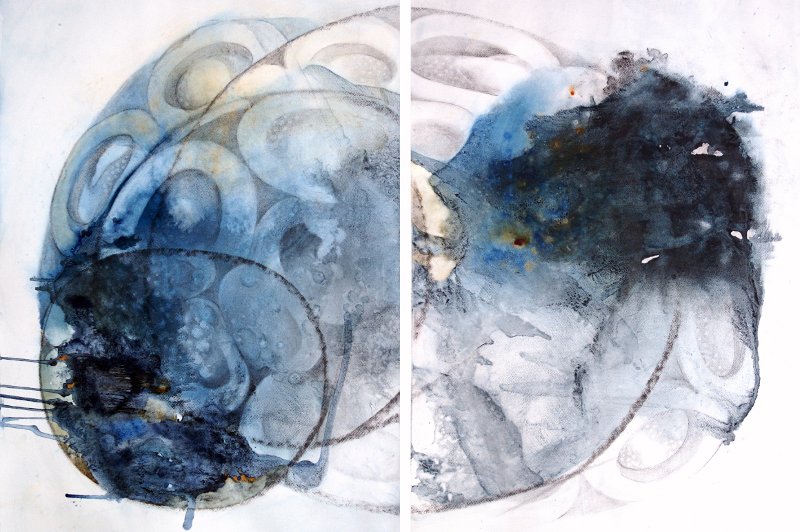Living Data
Big Picture Story 01:
First living cells
Algae are tiny marine 'bugs' that use sunlight, seawater and waste carbon dioxide to capture light energy by photosynthesis... [they] act as a natural sponge that soaks up excess carbon dioxide from the atmosphere.
Supriya Guruprasad, Dale Radford & Martin Schliep, UTS C3 Algae Biofuelfuel Group (ABG)
The first living cells (Bacteria with the power of self-replication and metabolism making them alive) were born in the hot "chemical soup" that was the Primaeval ocean nearly 4 billion years ago. Earth had cooled sufficiently by then from its molten, fiery beginnings to have liquid water - and Water and Life are inseparable.
All Living things, in the Bacterial, Protist (including Algae), Fungal, Plant and Animal Kingdoms that evolved since then, including you and me, can trace an ancestry back to those first cells in an unbroken lineage on Life's Continuum.
Dr Mary E. White 2012

Sue Anderson. Source Charcoal and liquid graphite on paper. 2012
This was one of a series of works that emerged from a long, almost two-year struggle, to find ways of using phytoplankton forms that would highlight their vital significance to all life - their lynchpin function. Finally, I moved to the spontaneous, even bodily approach - and reflectively/meditatively allowed the images to emerge or be coaxed from spontaneous pours of carbon and pigment scatters - I found it was a deep process, or inward dreaming by that point, this searching for a way of expressing the fundamental, source element - natural carbon sinks now under pressure from our carbon pollution, represented here by the charcoal and liquid graphite pours.
Sue Anderson Hobart, 9 February 2012
Lisa Roberts Vast and minute scales
Animation 2011
Data: Martina Doblin, Data Centre, Australian Antarctic Division; United States Geological Survey; Nicholas Kiraly
Music: Sophie Green
Dancers: Margaret Bowman, Catherine Magill, Lisa Roberts
Minute algae in water and alveoli (air sacks) in our lungs may seem remote from the vast Antarctic sea ice and yet these systems are interconnected. Algae produce the oxygen we breathe. Sea ice production maintains global overturning circulation of the ocean that replenishes life. In the animation, the rhythmic pattern of breath is reflected in the annual contraction and expansion of Antarctic sea ice.
Lisa Roberts
Lisa Roberts Scales of interest
Animation 2011
Voices: Andrew Constable, Lisa Roberts
Mucic: Sophie Green
Dancers: Helen Clarke Lapin, Mike Green, Caterina Mocciola
Helen Clarke Lapin, Mike Green and Caterina Mocciola dance in response to hearing Mary E. White descrie The Big Picture. I video record the dance and trace and animate their gestures of connection.
Climate models predict that the ocean's physical circulation and chemical properties will shift significantly in the coming decades, affecting phytoplankton production and floristics (Boyd et al. 2008). Our analysis of long-term coastal data sets demonstrates changes have already occurred in a range of ocean properties within Australia's continental shelf waters. For most properties, the magnitude of change varied by season and the timing has important implications for the biological responses. Changes such as stratification and surface nutrient and chl a concentrations at the 4 Australian coastal stations were not consistent with predictions by existing spatially coarse, global climate change models, indicating the need for greater emphasis on regional observation and interpretation. Only with improved observations can we hope to link local- and regional-scale environmental changes with their biological responses. Achieving this level of observation is a significant challenge for the marine science community, but necessary if we wish to understand the impacts of climate variability and the consequent implications for our marine ecosystems.
Conclusion, Long-term changes in temperate Australian coastal waters:
implications for phytoplankton
Published: 2009 Marine Ecology Progress Series.
DOI: 10.3354/meps08297/NOV 18.
Authors: P. A. Thompson1, M. E. Baird, T. Ingleton, M. A. Doblin











